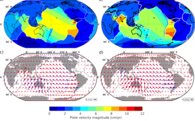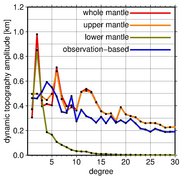Relationship between mantle convectio, lithosphere dynamics and geoid on Earth, Moon and Planets
Mantle convection provides the driving forces for tectonic plate motions on Earth. By striving for the best possible match between numerical model results and observation data (Figure 1), we constrain plate boundary friction and asthenosphere viscosity (Osei Tutu et al., 2018). We also model lithospheric stresses (Osei Tutu et al., 2018), vertical deflection of the lithosphere – so-called dynamic topography (Steinberger, 2016) and the geoid (Ghosh et al., 2017), which all can be compared to observations. An important ingredient of such models is lithosphere thickness (Steinberger and Becker, 2016). A big discrepancy exists for dynamic topography at spherical harmonic degree two: The model predicts much larger amplitude than observed, due to density anomalies in the lower mantle (Steinberger et al, in press; Figure 2). We extend our models to other terrestrial bodies, such as the Moon (Steinberger et al., 2015) to improve our knowledge about interior structure and processes. We are also interested in how dynamic topography may influence surface processes. For example, we have developed a scenario how hot material sourced in the Iceland plume has uplifted eastern Greenland, and this process, together with northward motion of Greenland due to both plate motions and true polar wander, has been a contributing factor to the onset of northern hemisphere glaciations (Steinberger et al., 2015).



